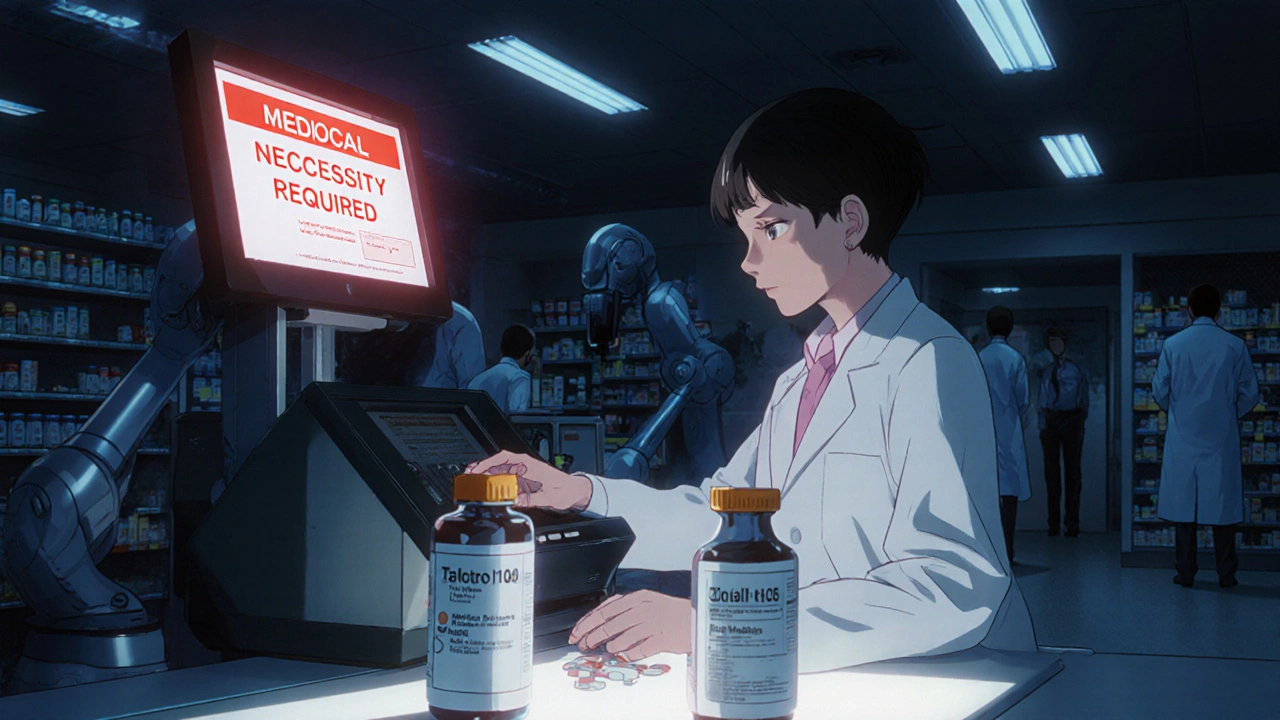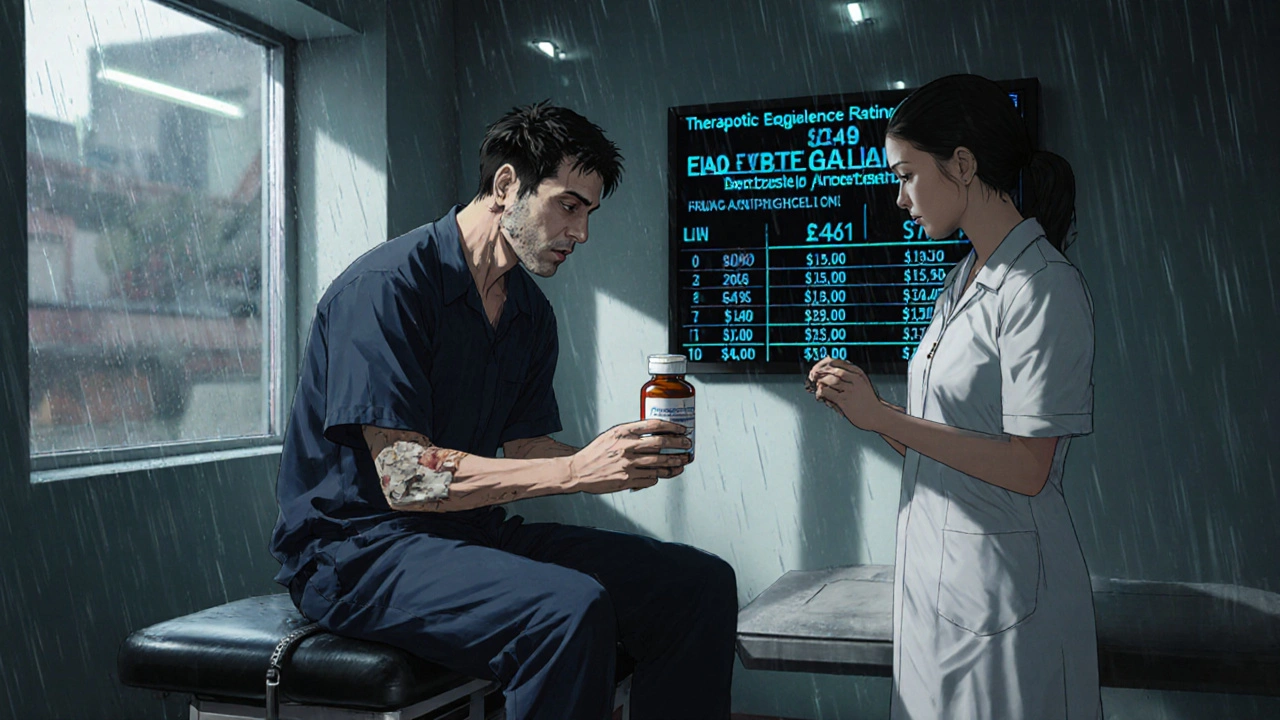When a worker gets hurt on the job, the goal is simple: get them back on their feet as quickly and safely as possible. But behind the scenes, a quiet battle is being fought over what pills they get to take. In workers’ compensation systems across the U.S., generic substitution has become one of the biggest levers for controlling costs-without sacrificing care. And by 2025, it’s no longer optional in most states. It’s the standard.
Why Generic Drugs Are the Default in Workers’ Comp
Generic drugs aren’t cheap knockoffs. They’re FDA-approved copies of brand-name medications with the same active ingredients, same strength, same dosage form, and same way of working in the body. The difference? Price. A brand-name painkiller like Voltaren Gel might cost $120 for a tube. The generic version? Around $20. That’s not a small saving-it’s an 80% drop. And in workers’ compensation, where pharmacy costs make up nearly 20% of total medical spending, those savings add up fast. In 2015, generic drugs were used in 84.5% of managed prescriptions in workers’ comp. By 2023, that number jumped to 89.2%. In California, it’s over 92%. States like Colorado now require 95% generic use for drugs on their official formulary, starting in 2024. This isn’t random. It’s policy. The Hatch-Waxman Act of 1984 laid the legal groundwork for this shift. It created a clear path for generic manufacturers to bring safe, effective copies to market without repeating expensive clinical trials. Since then, brand-name drug prices have soared-up 159% in list price over ten years, according to JAMA. Meanwhile, generic prices fell by 35% in the same period. Milk and bread? Just 7.4% inflation. The math is clear: generics are the smart choice.How Generic Substitution Works in Practice
It’s not as simple as swapping one pill for another. There’s a system behind it. Pharmacy Benefit Managers (PBMs)-companies like OptumRx, Express Scripts, and Prime Therapeutics-control the formularies that dictate which drugs are covered and under what conditions. These formularies are built around the FDA’s Orange Book, which rates drugs by therapeutic equivalence. If a generic is rated AB, it means it’s considered interchangeable with the brand. In states with strong formularies, like Tennessee, the rules are strict: doctors must prescribe generics unless they document medical necessity for a brand. That means not just saying “the patient prefers it.” They need clinical reasons-like an allergic reaction to an inactive ingredient, or a documented failure of the generic version. This creates a workflow. When a claimant’s doctor writes a prescription for a brand-name drug, the pharmacy flags it. The PBM sends back a request for justification. If the doctor doesn’t respond, the generic is dispensed automatically. It’s efficient. It’s controlled. And it saves money-big time.What Happens When Generics Don’t Work?
You’ve probably heard the myth: “Generics don’t work as well.” It’s persistent. A 2019 survey found 68% of injured workers believed brand-name drugs were better. But when they actually used generics, 82% said they worked just as well. There are exceptions. For drugs with a narrow therapeutic index-like warfarin or levothyroxine-the margin for error is tiny. A slight difference in absorption can cause problems. Even then, the FDA requires generics to meet the same strict standards. Studies show therapeutic failures in these cases are rare-under 2% of all substitutions. The bigger issue isn’t science. It’s perception. Many doctors still default to brand names out of habit. Some patients resist because they’ve been told for years that “name brands are better.” Occupational health nurses report spending extra time explaining that the generic version of ibuprofen is chemically identical to Advil. The active ingredient? Ibuprofen. The effect? The same.
State Laws Are the Real Driver
This isn’t a federal mandate. It’s a patchwork of state laws. Forty-four states and D.C. have laws that either require or allow generic substitution in workers’ compensation. But the rules vary. In California, with its strict drug formulary, the system runs like clockwork. In states without formularies, generic use hovers around 83%. Virginia’s law is different-it allows broader exceptions for occupational diseases, making substitution less automatic. The trend is clear: more states are adopting formal drug formularies. As of 2023, 38 states have them. And those states see the highest generic rates. Why? Because they remove the guesswork. Doctors know what’s covered. Pharmacists know what to dispense. Adjusters know what to pay.Challenges and Controversies
It’s not all smooth sailing. Critics point to a growing problem: generic drug prices aren’t always low. In some cases, when only one or two companies make a generic, prices spike. Enlyte’s 2022 analysis found evidence of anti-competitive behavior among generic manufacturers-collusion on pricing, supply shortages, and market exits that leave no competition. There’s also the issue of specialty drugs. These are high-cost medications used for complex conditions like nerve damage or chronic pain. In 2023, they made up 12.7% of workers’ comp pharmacy spending-but only 4.3% had generic alternatives. That’s where the next frontier is: biosimilars. The first workers’ comp biosimilar substitution happened in Texas in 2022. These are complex biological drugs that mimic brand-name biologics. They’re harder to copy, but they’re coming. And then there’s the human factor. Some injured workers feel disrespected when their prescribed brand is swapped out. Providers who don’t understand the system struggle with prior authorization delays. One occupational health clinic in Ohio reported that 73% of their patients needed extra education before accepting a generic.
What Employers and Providers Should Do Now
If you’re managing a workers’ comp claim, here’s what you need to do:- Know your state’s formulary. If it has one, follow it. If not, push for one.
- Train your medical providers. Make sure they understand therapeutic equivalence and how to document medical necessity correctly.
- Educate your workers. Give them a simple handout: “Generic drugs have the same active ingredient. They work the same way. They’re just cheaper.”
- Work with your PBM. Ask for reports on generic utilization and cost savings. Demand transparency.
- Don’t assume brand = better. The science says otherwise.
The Future Is Generic
By 2025, generic drug use in workers’ compensation is projected to hit 93.5%. That’s up from 89.2% in 2023. Why? Because brand-name drugs keep getting more expensive, and the system can’t afford it. The next wave will be personalized medicine. Pharmacogenomic testing-checking a patient’s genes to predict how they’ll respond to a drug-is starting to appear in some programs. That could mean generics aren’t just cheaper-they’re smarter. Instead of a one-size-fits-all approach, you’ll get the right drug for the right person, whether it’s generic or brand. But for now, the message is clear: in workers’ compensation, generic substitution isn’t a cost-cutting trick. It’s evidence-based care. It’s the law in most places. And it’s saving billions every year without putting workers at risk.When it comes to treating workplace injuries, the best medicine isn’t the most expensive one. It’s the one that works-and doesn’t break the bank.
Are generic drugs really as effective as brand-name drugs in workers’ compensation?
Yes. The FDA requires generic drugs to have the same active ingredients, strength, dosage form, and bioequivalence as their brand-name counterparts. This means they work the same way in the body. Studies show 82% of injured workers report no difference in effectiveness after switching to generics, despite initial skepticism. The difference is price, not performance.
Can a doctor still prescribe brand-name drugs in workers’ comp?
Yes, but only if they document medical necessity. In states with formal drug formularies-like Tennessee or California-prescribers must provide a clinical reason beyond patient preference. Examples include documented allergic reactions to inactive ingredients, therapeutic failure of the generic, or a narrow therapeutic index where even minor differences matter. Simply saying “the patient likes the brand” isn’t enough.
Why are some generic drugs more expensive than others?
When only one or two manufacturers produce a generic, competition drops-and prices can rise. This is called a “generic drug monopoly.” Enlyte’s 2022 analysis found cases where manufacturers colluded to limit supply or delay entry of competitors, driving up costs. This is why some older generics still cost more than expected, even though they’ve been off-patent for years.
Which states require generic substitution in workers’ compensation?
Forty-four states and the District of Columbia have laws that either require or permit generic substitution where medically appropriate. States with formal drug formularies-like California, Colorado, and Tennessee-have the strictest rules. Virginia has more permissive language for occupational diseases. Always check your state’s workers’ compensation medical fee schedule for exact rules.
Do generic drugs cause more side effects?
No. The FDA requires generics to meet the same safety and quality standards as brand-name drugs. Side effects come from the active ingredient, which is identical. Differences in inactive ingredients (like fillers or dyes) can rarely cause allergic reactions, but this is uncommon and not specific to generics. The rate of adverse events is the same across both types of drugs.
What’s the difference between a generic and a biosimilar?
Generics are exact chemical copies of small-molecule drugs like ibuprofen or acetaminophen. Biosimilars are highly similar-but not identical-copies of complex biological drugs like those used for nerve pain or inflammation. Biosimilars are harder to produce and replicate, so they’re newer to workers’ comp. Texas began allowing them in 2022. They’re the next frontier in cost control for high-priced specialty drugs.
How can employers reduce resistance from injured workers?
Provide clear, simple education. Use handouts or videos that explain: “The generic version has the same active ingredient and works the same way. The only difference is the price.” Share data: 82% of workers report no difference in effectiveness. Involve nurses or case managers to answer questions. Trust builds when workers feel informed, not replaced.
Is generic substitution mandatory in all workers’ comp claims?
No. It’s mandatory only in states with laws or formularies requiring it. Even then, exceptions exist for documented medical necessity. In states without formularies, substitution is common but not required. Employers should know their state’s rules and ensure their claims administrators follow them consistently.





